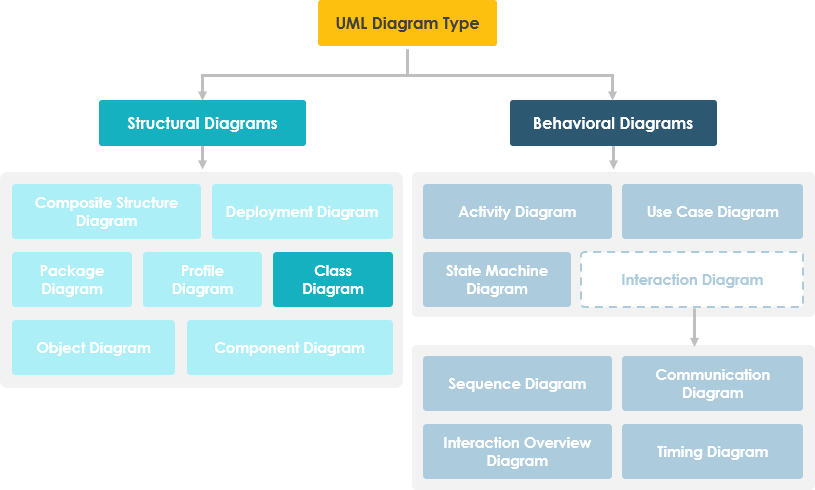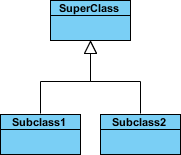
In software engineering, a class diagram in the Unified Modeling Language (UML) is a type of static structure diagram that describes the structure of a system by showing the system's classes, their attributes, operations (or methods), and the relationships among objects.

Learn UML Faster, Better and Easier
Are you looking for a Free UML tool for learning UML faster, easier and quicker? Visual Paradigm Community Edition is a UML software that supports all UML diagram types. It is an international award-winning UML modeler, and yet it is easy-to-use, intuitive & completely free.
Free Download
Purpose of Class Diagrams
- Shows static structure of classifiers in a system
- Diagram provides a basic notation for other structure diagrams prescribed by UML
- Helpful for developers and other team members too
- Business Analysts can use class diagrams to model systems from a business perspective
A UML class diagram is made up of:
- A set of classes and
- A set of relationships between classes
What is a Class
A description of a group of objects all with similar roles in the system, which consists of:
- Structural features (attributes) define what objects of the class "know"
- Represent the state of an object of the class
- Are descriptions of the structural or static features of a class
- Behavioral features (operations) define what objects of the class "can do"
- Define the way in which objects may interact
- Operations are descriptions of behavioral or dynamic features of a class
Class Notation
A class notation consists of three parts:
- Class Name
- The name of the class appears in the first partition.
- Class Attributes
- Attributes are shown in the second partition.
- The attribute type is shown after the colon.
- Attributes map onto member variables (data members) in code.
- Class Operations (Methods)
- Operations are shown in the third partition. They are services the class provides.
- The return type of a method is shown after the colon at the end of the method signature.
- The return type of method parameters is shown after the colon following the parameter name.
- Operations map onto class methods in code

The graphical representation of the class - MyClass as shown above:
- MyClass has 3 attributes and 3 operations
- Parameter p3 of op2 is of type int
- op2 returns a float
- op3 returns a pointer (denoted by a *) to Class6
Class Relationships
A class may be involved in one or more relationships with other classes. A relationship can be one of the following types: (Refer to the figure on the right for the graphical representation of relationships).
| Relationship Type | Graphical Representation |
|---|---|
| Inheritance (or Generalization):
|  |
| Simple Association:
|  |
| Aggregation: A special type of association. It represents a "part of" relationship.
|  |
| Composition: A special type of aggregation where parts are destroyed when the whole is destroyed.
|  |
| Dependency:
|  |
Relationship Names
- Names of relationships are written in the middle of the association line.
- Good relation names make sense when you read them out loud:
- "Every spreadsheet contains some number of cells",
- "an expression evaluates to a value"
- They often have a small arrowhead to show the direction in which direction to read the relationship, e.g., expressions evaluate to values, but values do not evaluate to expressions.

Relationship - Roles
- A role is a directional purpose of an association.
- Roles are written at the ends of an association line and describe the purpose played by that class in the relationship.
- E.g., A cell is related to an expression. The nature of the relationship is that the expression is the formula of the cell.
Visibility of Class attributes and Operations
In object-oriented design, there is a notation of visibility for attributes and operations. UML identifies four types of visibility: public, protected, private, and package.
The +, -, # and ~ symbols before an attribute and operation name in a class denote the visibility of the attribute and operation.
- + denotes public attributes or operations
- - denotes private attributes or operations
- # denotes protected attributes or operations
- ~ denotes package attributes or operations
Class Visibility Example

In the example above:
Access for each of these visibility types is shown below for members of different classes.
| Access Right | public (+) | private (-) | protected (#) | Package (~) |
|---|---|---|---|---|
| Members of the same class | yes | yes | yes | yes |
| Members of derived classes | yes | no | yes | yes |
| Members of any other class | yes | no | no | in same package |
Multiplicity
How many objects of each class take part in the relationships and multiplicity can be expressed as:
- Exactly one - 1
- Zero or one - 0..1
- Many - 0..* or *
- One or more - 1..*
- Exact Number - e.g. 3..4 or 6
- Or a complex relationship - e.g. 0..1, 3..4, 6.* would mean any number of objects other than 2 or 5
Multiplicity Example
- Requirement: A Student can take many Courses and many Students can be enrolled in one Course.
- In the example below, the class diagram (on the left), describes the statement of the requirement above for the static model while the object diagram (on the right) shows the snapshot (an instance of the class diagram) of the course enrollment for the courses Software Engineering and Database Management respectively)

Aggregation Example - Computer and parts
- An aggregation is a special case of association denoting a "consists-of" hierarchy
- The aggregate is the parent class, the components are the children classes

Inheritance Example - Cell Taxonomy
- Inheritance is another special case of an association denoting a "kind-of" hierarchy
- Inheritance simplifies the analysis model by introducing a taxonomy
- The child classes inherit the attributes and operations of the parent class.

Class Diagram - Diagram Tool Example
A class diagram may also have notes attached to classes or relationships. Notes are shown in grey.

In the example above:
We can interpret the meaning of the above class diagram by reading through the points as following.
- Shape is an abstract class. It is shown in Italics.
- Shape is a superclass. Circle, Rectangle and Polygon are derived from Shape. In other words, a Circle is-a Shape. This is a generalization / inheritance relationship.
- There is an association between DialogBox and DataController.
- Shape is part-of Window. This is an aggregation relationship. Shape can exist without Window.
- Point is part-of Circle. This is a composition relationship. Point cannot exist without a Circle.
- Window is dependent on Event. However, Event is not dependent on Window.
- The attributes of Circle are radius and center. This is an entity class.
- The method names of Circle are area(), circum(), setCenter() and setRadius().
- The parameter radius in Circle is an in parameter of type float.
- The method area() of class Circle returns a value of type double.
- The attributes and method names of Rectangle are hidden. Some other classes in the diagram also have their attributes and method names hidden.
Dealing with Complex System - Multiple or Single Class Diagram?
Inevitably, if you are modeling a large system or a large business area, there will be numerous entities you must consider. Should we use multiple or a single class diagram for modeling the problem? The answer is:
- Instead of modeling every entity and its relationships on a single class diagram, it is better to use multiple class diagrams.
- Dividing a system into multiple class diagrams makes the system easier to understand, especially if each diagram is a graphical representation of a specific part of the system.
Perspectives of Class Diagram in Software Development Lifecycle
We can use class diagrams in different development phases of a software development lifecycle and typically by modeling class diagrams in three different perspectives (levels of detail) progressively as we move forward:
Conceptual perspective: The diagrams are interpreted as describing things in the real world. Thus, if you take the conceptual perspective you draw a diagram that represents the concepts in the domain under study. These concepts will naturally relate to the classes that implement them. The conceptual perspective is considered language-independent.
Specification perspective: The diagrams are interpreted as describing software abstractions or components with specifications and interfaces but with no commitment to a particular implementation. Thus, if you take the specification perspective we are looking at the interfaces of the software, not the implementation.
Implementation perspective: The diagrams are interpreted as describing software implementations in a particular technology and language. Thus, if you take the implementation perspective we are looking at the software implementation.
Try to Draw UML Class Diagram Now
You've learned what a Class Diagram is and how to draw a Class Diagram. It's time to draw a Class Diagram of your own. Get Visual Paradigm Community Edition, a free UML software, and create your own Class Diagram with the free Class Diagram tool. It's easy-to-use and intuitive.
Free Download
Source: https://www.visual-paradigm.com/guide/uml-unified-modeling-language/what-is-class-diagram
Posted by: sodanoguillerminanoes.blogspot.com

0 Komentar